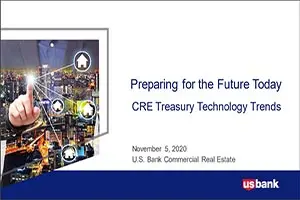
Webinar: CRE technology trends

Authenticating cardholder data reduce e-commerce fraud

This article was originally published as part of the 2022 CFO Insights Report from U.S. Bank.
There is no doubting the scale of the challenge. The IMF has already narrowed its 2022 global growth forecast to just 3.2%, down from growth of 6.1% in 2021. War in Ukraine and the disruptions caused by the COVID-19 pandemic are driving a global inflation spike, forcing central banks to tighten monetary policy – and consumers to tighten their belts.
It is little wonder, then, that CFOs and other finance leaders are anxious. New research from U.S. Bank reveals 30% are now prioritizing risk identification and mitigation, up from 18% a year ago. Worryingly, fewer than 15% are highly confident in their business’s ability to manage key risks.
Potentially, supply chain finance offers a way to take back control. A third-party finance provider – a bank, say, or a fintech business – comes into the supply chain, taking responsibility for settling a business’s invoices to a supplier; it gets these advances back once the customer pays the bill. Supply chain finance providers can work with either buyer or supplier. When they work with a supplier directly, the supplier can secure credit against invoices issued to customers.
There are clear benefits to both parties. And, in a recessionary environment, those benefits look more valuable than ever. Most obviously, supply chain finance arrangements can ease cashflow worries.
In a difficult market, buyers are keen to hold on to cash for as long as possible; they may even want to extend their terms of payment. Conversely, suppliers need their invoices to be settled faster. Supply chain finance can help both sides achieve their objectives. Buyers settle their invoices on payment terms that their businesses can manage. Suppliers, meanwhile, do not have to wait for this settlement and control when they draw down the cash.
Supply chain finance arrangements also improve visibility. Transactions are managed through the provider’s technology platform, providing a valuable data feed on accounts receivable and payable – and enabling finance to forecast, and therefore plan, more effectively.
Importantly, this is non-recourse lending: with finance agreed against quantified invoices for products and services provided. Unlike with traditional bank finance, there is no need for additional collateral. The latter may, in any case become tougher to secure, as economic headwinds prompt lenders to become more conservative, and more expensive as interest rates rise.
There is also a potential cost advantage. The often-smaller supplier should be able to leverage the buyer’s better cost of capital.
The benefits to both parties provide an opportunity to build much closer relationships between them.
This could prove especially important during this period of ongoing supply chain disruption. Suppliers are having to make difficult decisions about which customers to prioritize and how to manage delays. Buyers, meanwhile, live in constant fear of supply chain failures. In the U.S. Bank research, 25% of finance leaders cite supply chain disruption as a top business risk, while 35% are prioritizing work to evaluate the credit risk of major customers.
The good news is that the supply chain finance market is now evolving at pace. Supply chain products that might once have been available only to corporates with high-grade credit ratings are now offered more widely, with new technologies supporting access.
Products are also evolving, particularly as technology supports new features. Some providers are focused on how to give suppliers even earlier access to finance – perhaps at manufacturing stage, which may be when working-capital pressures bite particularly hard. Others are looking at how to embed solutions into the extended supply chain.
Environmental, social and governance (ESG) considerations are also growing in importance. Some providers now offer cheaper credit to suppliers that meet certain ESG criteria; there is an opportunity to align these criteria with the ESG objectives of the buyer in order to support its own ESG agenda.
More broadly, buyers that are able to give their suppliers access to supply chain finance will have a better, and fairer, relationship with those suppliers – an ESG issue of growing importance – while simultaneously protecting their own cashflow.
Importantly, U.S. Bank’s research suggests that, while many finance leaders are concerned about supply chain pressures, only a minority are taking practical steps to address their anxieties. Fewer than four in 10 are exploring ways to mitigate supply chain risk.
Supply chain finance represents a clear opportunity for finance leaders to play an important role in addressing this issue. However, this may require intervention in matters that Treasurers and Procurement teams more typically deal with. CFOs and other finance leaders must seize the initiative, setting a clear strategic direction for the business by working closely with these colleagues to secure supply chains.
In the end, CFOs are unlikely to take direct charge of improving supply chain finance arrangements, but they can act as catalysts, ensuring the broader finance and procurement functions work together in a symbiotic relationship. As the economic storm clouds gather, the imperative for this kind of mutual protection through collaboration will only increase.
We surveyed 750 senior finance leaders to see how they are navigating a new wave of unexpected challenges, including rampant inflation, talent shortages and supply chain bottlenecks. Explore their answers in the 2022 CFO Insights Report from U.S. Bank.
Related content


